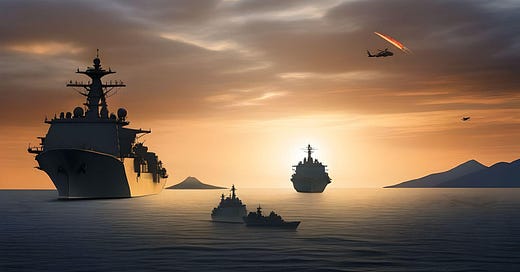The Balance of Power
Assessing the Role of Hard and Soft Power in Emerging Countries’ Global Influence
Emerging countries, often referred to as rising powers or developing nations, are increasingly asserting their presence on the global stage. As these nations seek to extend their influence, the debate over the relative importance of hard and soft power becomes particularly relevant. Hard power, defined by military might and economic strength, contrasts with soft power, which encompasses cultural influence, diplomacy, and the ability to shape preferences through attraction rather than coercion. The extent to which emerging countries need both forms of power to extend their global influence is a crucial question that requires a nuanced understanding of global dynamics.
The Importance of Hard Power
Hard power remains a cornerstone of international relations, providing the most immediate and tangible means of influence. For emerging countries, military capability and economic strength are vital in establishing themselves as significant players on the global stage. Hard power, however, is not a viable option for many emerging powers, even for the largest among them, like China. This is primarily because the United States spends significantly more on its military than any other country, making it the world's sole military superpower. While all BRIC countries (Brazil, Russia, India, and China) possess nuclear capabilities—a relatively inexpensive way to assert some level of hard power—they use this primarily as a defensive measure. Additionally, having nuclear weapons grants them a seat on the United Nations Security Council, which greatly enhances their global influence. On the other hand, other emerging countries, which are more marginalised, have little choice but to rely on soft power to extend their influence.
Military Power: Military strength, or the ability to project power and defend national interests, is a traditional measure of a country’s global standing. Nations such as China and India have invested heavily in modernising their military forces, recognising that a credible military presence can deter aggression, secure regional influence, and support global ambitions. China's military moderniation and assertiveness in the South China Sea exemplify how hard power can be used to assert territorial claims and influence regional geopolitics .
Economic Power: Economic strength is equally crucial. Emerging economies like China, India, and Brazil leverage their economic growth to gain influence in international institutions and create dependencies through trade and investment. China’s Belt and Road Initiative (BRI), which involves massive infrastructure investments across Asia, Africa, and Europe, is a prime example of how economic power can extend a nation’s influence by creating economic ties and dependencies. These investments, coupled with financial aid and development assistance, have allowed China to wield significant influence in regions traditionally dominated by Western powers.
The Role of Soft Power
While hard power is essential, it is often insufficient on its own to sustain global influence, especially in an interconnected world where the projection of force can lead to backlash and resistance. This is where soft power becomes critical. Soft power, the ability to attract and co-opt rather than coerce, helps emerging countries build a positive image and foster goodwill, which can be invaluable in achieving long-term strategic goals.
Joseph Nye coined the term "soft power," but even before this concept was formally named, powerful and larger countries had long used various methods to extend their influence over smaller, less powerful nations without resorting to direct invasion. These methods were often referred to as "diplomacy" or "economic colonialism." According to Nye, soft power is the ability to attract and persuade others rather than compel them through force, as hard power does. Hard power typically involves using military strength as a means of persuasion, whereas soft power influences the policies of others through appeal and attraction. The most well-known aspects of soft power include the use of culture and economic aid to extend a nation's influence.
Cultural Influence: Cultural exports such as media, education, and arts can significantly enhance a country's global standing. For instance, South Korea’s rise as a cultural powerhouse, driven by the global popularity of K-pop, Korean cinema, and television dramas, has significantly boosted its international profile and influence, a phenomenon often referred to as the "Korean Wave" or "Hallyu”. This cultural influence helps build a favourable global image and creates a platform for diplomatic engagement.
Diplomacy and International Cooperation: Soft power also involves active participation in international organisations and the promotion of diplomatic initiatives that align with global values. Countries like India have used soft power through their leadership in non-aligned movements and contributions to United Nations peacekeeping missions, positioning themselves as champions of global peace and co-operation . India's promotion of yoga and its democratic values also enhance its soft power appeal.
The Synergy of Hard and Soft Power
For emerging countries, the most effective strategy often lies in the combination of hard and soft power, a concept known as "smart power." This approach allows nations to leverage the strengths of both hard and soft power to create a comprehensive and adaptable foreign policy.
China's Smart Power: China is a key example of a nation using smart power. While it invests heavily in military capabilities and economic initiatives like the BRI, it also promotes its culture and language through Confucius Institutes worldwide and invests in global media outlets to influence international narratives. This blend of hard and soft power has enabled China to extend its influence globally, though not without challenges and resistance, particularly from Western nations wary of its intentions.
China, as the most prominent economic competitor to the United States, illustrates how the combination of hard and soft power is often used to extend economic influence. The U.S. has a poor reputation in some parts of the world due to its history of military aggression, which creates opportunities for countries like China and India to extend their influence. While these countries may struggle to compete with the U.S. in areas like film and food, which are key components of American soft power, they excel in using trade deals and development aid to build influence. China has been particularly successful in Africa, securing access to vital raw materials for its companies, as seen in Angola. Similarly, South Korea has leveraged soft power to establish links with Bolivia, aiding in the development of its lithium industry.
India's Balanced Approach: India also demonstrates the benefits of a balanced approach. While it continues to strengthen its military and economic capabilities, it also emphasises soft power through cultural diplomacy and leadership in international forums. India's active engagement in climate change negotiations and its promotion of digital technology as a development tool highlight its use of soft power to complement its growing hard power.
The Challenges of Balancing Hard and Soft Power
Despite the advantages of using both hard and soft power, emerging countries face challenges in achieving the right balance. Overreliance on hard power can lead to international isolation or provoke counterbalancing actions by other powers. Conversely, soft power alone may be insufficient to protect national interests in a competitive and sometimes hostile global environment.
For instance, Russia, another emerging power, has faced significant backlash for its aggressive use of hard power in Ukraine and other regions, which has undermined its global standing despite its efforts to wield soft power through media and cultural outreach. This highlights the risks of a hard power-dominant strategy, particularly when it is perceived as threatening by the international community.
Conclusion
Emerging countries need both hard and soft power to effectively extend their global influence. Hard power provides the necessary tools for immediate and tangible influence, while soft power builds long-term goodwill and cultural ties that are crucial in today’s interconnected world. The synergy of these powers, through a smart power strategy, allows emerging nations to navigate the complexities of global politics, enhance their international standing, and achieve their strategic objectives. By contrasting themselves with the more forceful stance of the U.S., these nations have ample opportunities to position themselves as "friends" and build positive relationships globally. While the importance of soft power is clear, the discussion also underscores the need for a deeper analysis of the limitations of military power, especially for emerging nations that cannot compete with the military dominance of the United States.
The challenge lies in finding the right balance, as the overemphasis on one form of power at the expense of the other can lead to unintended consequences and limit a country’s overall influence.
References
Nye, J. S. (2004). Soft Power: The Means to Success in World Politics. PublicAffairs.
Mearsheimer, J. J. (2001). The Tragedy of Great Power Politics. W. W. Norton & Company.
Lee, S. J. (2009). "The Korean Wave: The Seoul of Asia." The Hollywood Reporter.
Nye, J. S. (2011). The Future of Power. PublicAffairs.
Panda, A. (2020). "China’s Military Modernization: The Hard Power Side of the Belt and Road." The Diplomat.
Rolland, N. (2017). "China’s ‘Belt and Road Initiative’: Underwhelming or Game-Changer?" The Washington Quarterly, 40(1), 127-142.
Hong, E. (2014). The Birth of Korean Cool: How One Nation is Conquering the World Through Pop Culture. Simon & Schuster.
Malone, D. M. (2011). Does the Elephant Dance? Contemporary Indian Foreign Policy. Oxford University Press.
Kurlantzick, J. (2007). Charm Offensive: How China's Soft Power Is Transforming the World. Yale University Press.
Hall, I. (2012). India’s New Foreign Policy Strategy. Oxford University Press.
Conley, H. A., & Melino, M. (2020). Russian Hard Power: Living in Putin's World. CSIS Reports.







